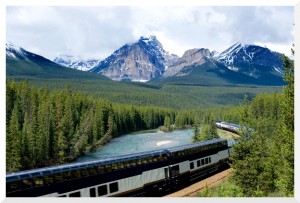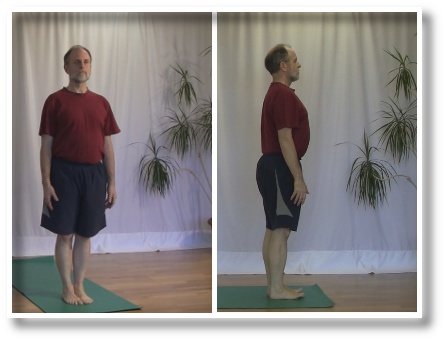“Boy! Are they ever tall!” thought Alice as she gazed out of the dome car of the train as it approached the Rocky Mountains. This is Alice’s first time seeing the Rocky Mountians. Now she understands her yoga teacher even better when they said to stand tall like a mountain in Tadasana.
What is Tadasana
Tadasana (pronounced tah-DAHS-anna) is the Sanskrit name for a very basic yoga pose. The name translates as mountain pose. In this pose you are standing tall and still like a mountain.
Tadasana is the pose that you are in before and after each standing yoga pose. There is no twisting, bending or binding in this pose, but surprisingly there are quite a few benefits.
When you do Tadasana you are improving your posture, strengthening your legs, abdomen and backside. It also helps to reduce flat feet and relieve sciatica.
To get the most out of Tadasana you need to do it properly starting with your foundation.
How to do Tadasana
To build a mountain you start with the foundation and work your way to the peak.
Start with your feet
The foundation of Tadasana is your feet. You start by bringing them together with your big toes touching and a slight gap between your heels. This arrangement makes the outside edges of your feet parallel.
Once your feet are together you need to get your weight in the right place above your feet. To do this you start by leaning forward, shifting your weight into your toes and then leading backwards shifting your weight back into your heels. Now shift your weight so there is an equal amount of weight in your toes and your heels.
Next it is time to work on your side to side weight distribution. Shift all of your weight on to one foot and then shift it to the other foot. Now share the weight of your body equally between your two feet.
Once you have your weight centred equally between your two feet, front to back and side to side, you will feel like your body can move in any direction easily. This is the feeling that you are looking for. This is the sign that you have your body’s weight centred over you feet. Now it is time to move on to your legs and get them set up for the pose.
Setup your legs
Your legs are the next stop on the climb to the top of the mountain in Tadasana.
Your legs should be straight but your knees should not be locked. Locking your knees will cause the knee joint to move backwards, hyper extending, and this will hurt your knees. To avoid this bend your knees very slightly. Your legs will still be straight even though your knees are slightly flexed.
Moving up from your legs and your knees you come to your hips.
Fix your hips
Visualize your hips as a bowl full of water. You do not want any water to spill out of this bowl. Check out your bowl of water by bring your hands to the top of your hips. You may discover that your hips are tipped forward or backwards.
To correct your forward tipping hips, tuck your tail bone in slightly until you feel your hips coming to a level position. To correct a backward tip, move the top of your hips forward until the backward tip is gone.
These two movements will prevent you from pouring water out of your bowl and will help to protect your spine.
Alice’s train is approaching the tree line as it continues its trip up the mountain and we continue our trip up the mountain as we work our way up the spine.
Adjust your spine
If your hips are tipped forward you will be compressing your lower back and if your hips are tipped backwards you will be removing the natural curve from your lower back and making it susceptible to injury.
Bring awareness to your spine. You should be tall with all of the natural curves in your spine. Avoid lifting your ribs and arching your back. Also avoid dropping your ribs which compresses your abdomen and rounds your back. Bring your ribs to a neutral position and stand as tall as possible.
At the top of your spine are your shoulders which have a major impact on the shape of your spine.
Flex your shoulders
The position of your hips has an impact on your lower spine and your shoulders have an impact on your upper back.
Bring awareness to your upper back and your shoulders. Most of us will have our shoulders drawn forward and down causing roundness in our upper back and tension in your neck.
To correct this roundness, draw your shoulders down from your ears and bring your shoulder blades towards each other. This will cause some stretching in the muscles in the front of your chest and at the same time it will remove the roundness in your upper back and reduce the tension in your neck muscles.
Your shoulders once they are in the correct place will be above your hips and your arms will be resting by your sides with your palms facing inwards and your fingers pointing down.
Now that your shoulders and arms are taken care of, you finish the journey up your body by checking out your head the peak of the mountain.
Focus your gaze
To get your head in the best place bring your gaze to the horizon in front of you. By focusing your gaze on the horizon your draw your awareness inwards to your body and how the pose feels. You are not looking around at the other people doing Tadasana and wondering if you are doing better or worse than them.
Gaze to the horizon and focus on your body and your breath as you hold the pose for several breaths.
You may discover when you check out your body once you settle into Tadasana that you are having a few problems with the pose.
Short hamstrings
Many people when they start yoga discover that they have short hamstrings. Tadasana is one of the poses where the short hamstrings will show up.
When you straighten your legs you will discover that your hips tip backwards and down towards the floor. This tipping will cause problems with your lower back.
To avoid hurting your lower back, flex your legs by bending your knees slightly until your hips are level once more. Getting your hips level will restore the proper curves to your lower back and protect it from injury.
Now use your edge to work on your short hamstrings and eventually you will be able to stand tall in Tadasana with straight legs.
Short hamstrings is not the only problem that you can have with your legs in this pose. You may have problems keeping your knees from flexing and locking.
Locking knees
If you are not used to standing with your knees flexed a little bit you will discover that your knees keep locking on you. You move to flex them and then they flex a whole lot. You move to straighten them out and then they lock again.
This problem will diminish over time the more you practice keeping your knees flexed. Bring your awareness to your knees. When you notice that they are locked restore that slight bend to them. To keep them from moving back into the locked position, draw your knee caps up towards your hips.
Summary
Tadasana is pose that we do every day when ever we are standing up. To get the most benefit from this pose and to be able to stand like a mountain for a long time, you need to get all of the alignments correct.
Like Alice’s train trip into the Rocky Mountains, you start at the base of the mountain and you work you way up to the peak.
Start with your feet and work your way up to your head as move into the pose. Keep your weight centred over you feet and gaze to the horizon and you too can be a mountain.
Next Step
Ask your teacher to check out your mountain pose so you can get the maximum benefit and avoid injuring yourself.
Additional Reading
To find out more about using your edge to improve your yoga poses read How to use your edge to stay on the cliff.
Reading How to avoid the turtle effete in Uttanasana give you another perspective on dealing with your shoulders in a yoga pose.
To learn some more techniques about working with short hamstrings check out 3 ways to protect your hamstrings in Paschimottanasana.





